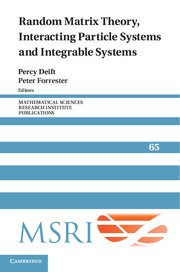Book contents
- Frontmatter
- Contents
- Preface
- Universality conjecture for all Airy, sine and Bessel kernels in the complex plane
- On a relationship between high rank cases and rank one cases of Hermitian random matrix models with external
- Riemann–Hilbert approach to the six-vertex model
- CLT for spectra of submatrices of Wigner random matrices, II: Stochastic evolution
- Critical asymptotic behavior for the Korteweg–de Vries equation and in random matrix theory
- On the asymptotics of a Toeplitz determinant with singularities
- Asymptotic analysis of the two-matrix model with a quartic potential
- Conservation laws of random matrix theory
- Asymptotics of spacing distributions 50 years later
- Applications of random matrix theory for sensor array imaging with measurement noise
- Convolution symmetries of integrable hierarchies, matrix models and τ-functions
- Universality limits via “old style” analysis
- Fluctuations and large deviations of some perturbed random matrices
- Three lectures on free probability
- Whittaker functions and relatedstochastic processes
- How long does it take to compute the eigenvalues of a random symmetric matrix?
- Exact solutions of the Kardar–Parisi–Zhang equation and weak universality for directed random polymers
- Replica analysis of the one-dimensional KPZ equation
- Asymptotic expansions for β matrix models and their applications to the universality conjecture
- KPZ scaling theory and the semidiscrete directed polymer model
- Experimental Realization Of Tracy–Widom Distributions And Beyond: Kpz Interfaces In Turbulent Liquid Crystal
- Random matrices: the four-moment theorem for Wigner ensembles
Experimental Realization Of Tracy–Widom Distributions And Beyond: Kpz Interfaces In Turbulent Liquid Crystal
Published online by Cambridge University Press: 29 May 2025
- Frontmatter
- Contents
- Preface
- Universality conjecture for all Airy, sine and Bessel kernels in the complex plane
- On a relationship between high rank cases and rank one cases of Hermitian random matrix models with external
- Riemann–Hilbert approach to the six-vertex model
- CLT for spectra of submatrices of Wigner random matrices, II: Stochastic evolution
- Critical asymptotic behavior for the Korteweg–de Vries equation and in random matrix theory
- On the asymptotics of a Toeplitz determinant with singularities
- Asymptotic analysis of the two-matrix model with a quartic potential
- Conservation laws of random matrix theory
- Asymptotics of spacing distributions 50 years later
- Applications of random matrix theory for sensor array imaging with measurement noise
- Convolution symmetries of integrable hierarchies, matrix models and τ-functions
- Universality limits via “old style” analysis
- Fluctuations and large deviations of some perturbed random matrices
- Three lectures on free probability
- Whittaker functions and relatedstochastic processes
- How long does it take to compute the eigenvalues of a random symmetric matrix?
- Exact solutions of the Kardar–Parisi–Zhang equation and weak universality for directed random polymers
- Replica analysis of the one-dimensional KPZ equation
- Asymptotic expansions for β matrix models and their applications to the universality conjecture
- KPZ scaling theory and the semidiscrete directed polymer model
- Experimental Realization Of Tracy–Widom Distributions And Beyond: Kpz Interfaces In Turbulent Liquid Crystal
- Random matrices: the four-moment theorem for Wigner ensembles
Summary
Analytical studies have shown the Tracy–Widom distributions and the Airy processes in the asymptotics of a few growth models in the Kardar–Parisi– Zhang (KPZ) universality class. Here the author shows evidence that these mathematical objects arise even in a real experiment: more specifically, in growing interfaces of turbulent liquid crystal. The present article is devoted to overviewing the current status of this experimental approach to the KPZ class, which directly concerns random matrix theory and related fields of mathematical physics. In particular, the author summarizes those statistical properties which were derived rigorously for simple solvable models and realized here experimentally, and those which were evidenced in the experiment and remain to be explained by further mathematical or theoretical studies.
1.Introduction
The first decade of the 21st century and a couple of preceding years have been marked by a series of remarkable analytical developments, which have revealed profound and rigorous connections among random matrix theory, combinatorial problems, and the physical problem of the fluctuating interface growth ([Baik and Rains 2001; Kriecherbauer and Krug 2010; Sasamoto and Spohn 2010a; Corwin 2012] and references therein). Their primary conclusions in terms of the interface growth problem, first pointed out by Johansson [2000] for TASEP and by Prähofer and Spohn [2000] for the PNG model, are the following [Kriecherbauer and Krug 2010; Sasamoto and Spohn 2010a; Corwin 2012]: (i) The distribution function and the spatial correlation function were obtained rigorously for the asymptotic interface fluctuations. (ii) The results depend on the global shape of the interfaces, or on the initial condition. For the two prototypical cases of the curved and flat growing interfaces, the distribution function is given by the Tracy–Widom distribution [Tracy and Widom 1994; 1996] for GUE and GOE, respectively, and the spatial two-point correlation function by the covariance of the Airy2 and Airy1 process [Prähofer and Spohn 2002; Sasamoto 2005],
respectively. (iii) All or some of these conclusions were reached for a number of models, namely the TASEP [Johansson 2000; Borodin et al. 2007; 2008; Sasamoto 2005] and the PASEP [Tracy and Widom 2009], the PNG model [Prähofer and Spohn 2000; 2002; Borodin et al. 2008], and the KPZ equation [Sasamoto and Spohn 2010c; 2010b; Amir et al. 2011; Calabrese et al. 2010; Dotsenko 2010; Calabrese and Le Doussal 2011; Prolhac and Spohn 2011].
Information
- Type
- Chapter
- Information
- Publisher: Cambridge University PressPrint publication year: 2014
